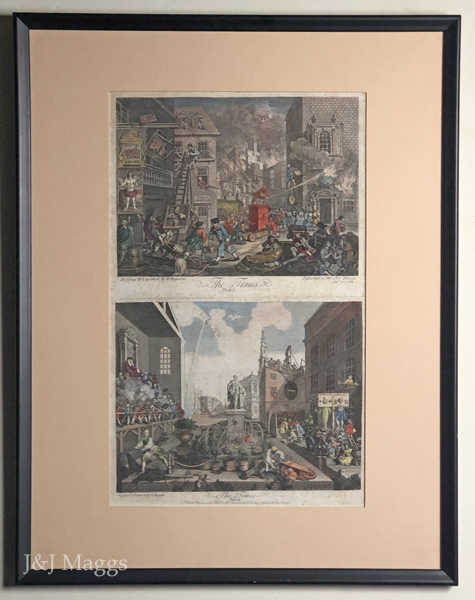
Jan & John Maggs
Antiques and Art
The Times, Parts 1 & 2
William Hogarth
~ ~ ~ ~ ~ ~ ~ ~ ~ ~ ~ ~ ~ ~ ~ ~ ~ ~ ~ ~ ~ ~ ~ ~ ~ ~ ~ ~ ~ ~ ~ ~ ~ ~ ~ ~ ~ ~ ~ ~ ~ ~ ~ ~ ~ ~

A colored period engraving by England’s best-known 18th-century satirist. Purchased from a local estate.
Please note: the foxing on this print does little to diminish the detail and the political significance of this important work by Hogarth.
Matted and framed identically to #27724.
English, 1762
Sight: 12⅛” X 19 ¾”; Frame: 21 ¼” X 27⅛”
Questions? Click HERE.
Price: $475
Inventory #27725
~ ~ ~ ~ ~ ~ ~ ~ ~ ~ ~ ~ ~ ~ ~ ~ ~ ~ ~ ~ ~ ~ ~ ~ ~ ~ ~ ~ ~ ~ ~ ~ ~ ~ ~ ~ ~ ~ ~ ~ ~ ~ ~ ~ ~ ~
William Hogarth's "The Times" (Plates One and Two) were created two years before his death, These engravings contain some of his most pessimistic imagery upon the political machinations and corruptions of the day. "The Times", Plate Two, in fact was suppressed by William Hogarth, and then his widow, and was not published until 1790 when John Boydell printed the plate for his set of original William Hogarth engravings. Both of these original impressions were published in London in 1822. A detailed examination of both plates will be found below. These are fine, original examples of the satirical art created by the British artist, William Hogarth.
The Times (Plates One and Two) were both designed and engraved by William Hogarth. They are printed upon early nineteenth century wove paper and with large, full margins as published by William Heath in 1822. The Times (Plates I) Paulson, Catalogue #211, Third and Final State & The Times (Plate II); Paulson, Catalogue #212, Fourth and Final State.
Plate I sets out to defend King George III and the ministry of the Earl of Bute. A fire, symbolic of war, has broken out in the background buildings. Each of these buildings represents a nation. The sign with the two men shaking hands represents Spain, the two headed eagle, Germany, and the lily, France. This wide sweeping conflagration has spread to the globe, to the right. Towering above his supporters by means of stilts is William Pitt, who is fanning the fire. Around his neck he wears a large millstone on which is inscribed '3000 L per annum', indicating his retirement pension.
A fire engine occupies the center of the scene. It represents both Britain and the King ('GR'). Aided by a Scot and other loyal supporters the King attempts to put out the fire within the globe. Above the engine flies a dove of peace. From the Temple Coffee House three individuals direct their water hoses not at the globe but at the King. The faceless character occupying the lower window is Earl Temple, Pitt's brother-in-law. The signs to the left all refer to Pitt and his supporters. One sign, 'Alive From America' advertises wealth to be gained from colonial exploitation.
In the foreground to the right are the refugees who have fled the European war. Two children and one adult have recently died. An insane man plays his fiddle. Turning such misery to financial gain, a Dutch merchant happily smokes his pipe to the lower left corner.
Plate II. As mentioned previously, publication of this engraving was suppressed by Hogarth during his lifetime. Occupying the center of the image is a statue of King George III. Water is drawn from this statue (by Lord Bute) and distributed to the shrubs around it. Royal favor is thus given. The largest shrub to the left is marked 'Culloden', and represents the Duke of Cumberland, who defeated the Scots at the bloody battle of that name. In the foreground to the right a gardener is busy dumping some shrubs (former favorites of the king) into the moat. His hat indicates that he is Henry Fox. He also trips over a roller on which the amount of national debt is written.
To the left sits Parliament, whose members sleep and chat or shoot at the dove of peace above the head of the statue. The figure with the longest and most damaging gun is William Pitt. In the background to the right construction is under way for the building known as the Society for the Encouragement of the Arts. They are busy hoisting up a large palette on which the word, 'Premium', is inscribed. This refers to the custom of offering prizes to young artists, a custom William Hogarth was more than suspicious of.
Below this building only a sprinkle of water remains for the general population. None reaches the maimed and crippled war veterans who are blocked from seeing the king. The ghost, Ms. Fanny (Conspiracy), and Wilkes (Defamation) receive punishment in the pillory. (From TheArtofthePrint.com)
~ ~ ~ ~ ~ ~ ~ ~ ~ ~ ~ ~ ~ ~ ~ ~ ~ ~ ~ ~ ~ ~ ~ ~ ~ ~ ~ ~ ~ ~ ~ ~ ~ ~ ~ ~ ~ ~ ~ ~ ~ ~ ~ ~ ~ ~
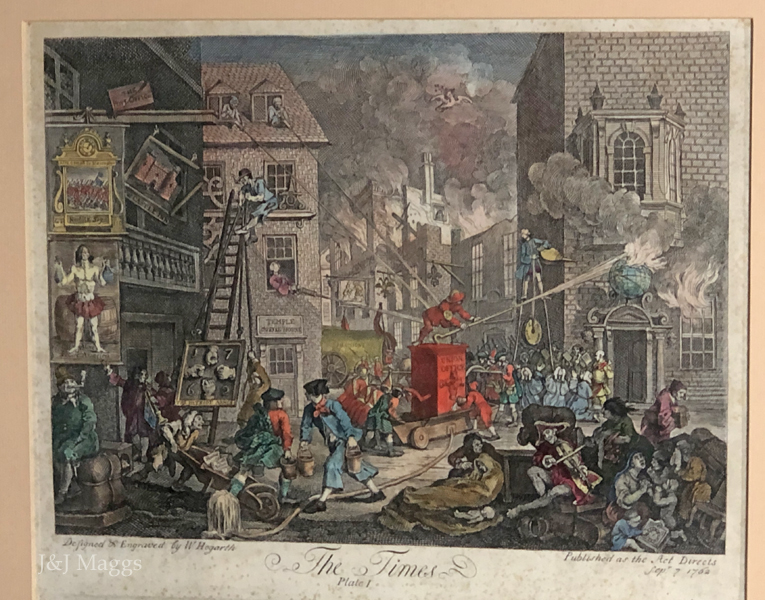
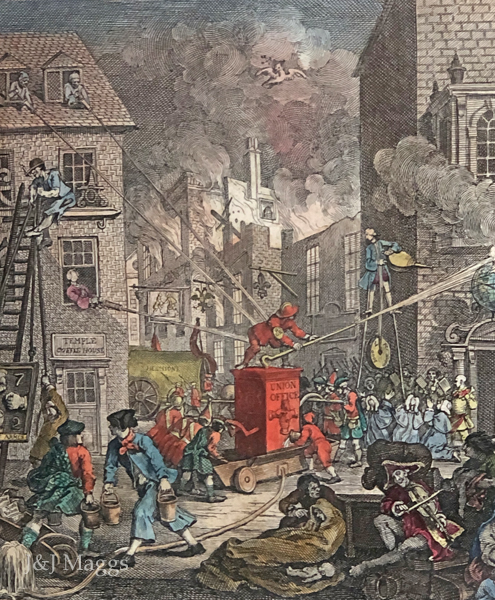
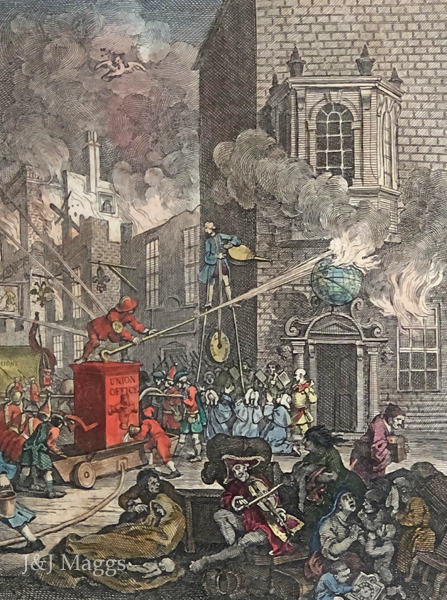

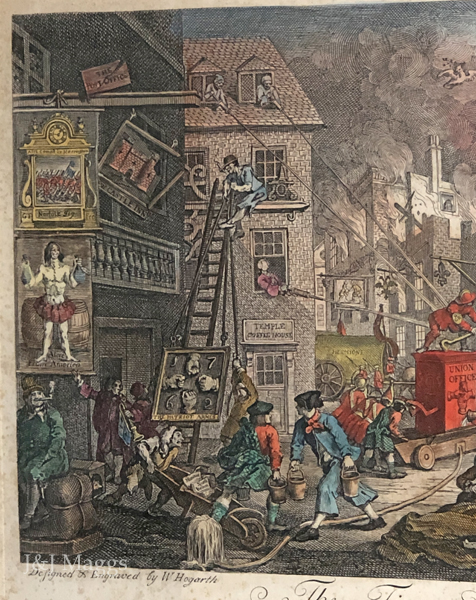
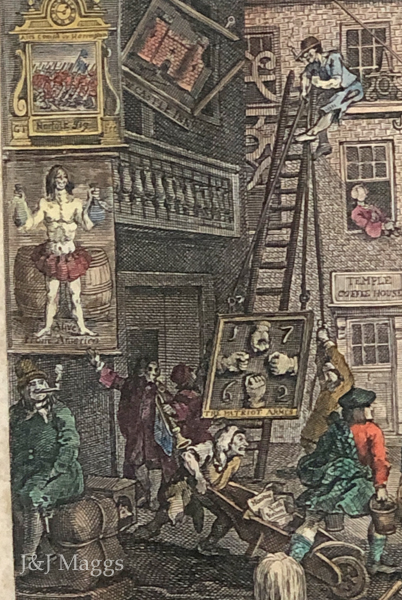
~ ~ ~ ~ ~ ~ ~ ~ ~ ~ ~ ~ ~ ~ ~ ~ ~ ~ ~ ~ ~ ~ ~ ~ ~ ~ ~ ~ ~ ~ ~ ~ ~ ~ ~ ~ ~ ~ ~ ~ ~ ~ ~ ~ ~ ~




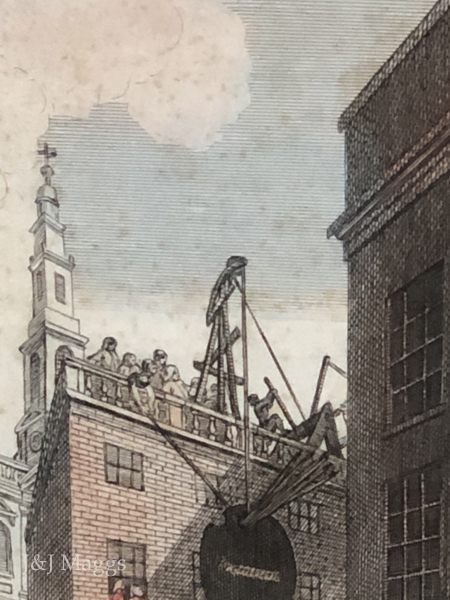
~ ~ ~ ~ ~ ~ ~ ~ ~ ~ ~ ~ ~ ~ ~ ~ ~ ~ ~ ~ ~ ~ ~ ~ ~ ~ ~ ~ ~ ~ ~ ~ ~ ~ ~ ~ ~ ~ ~ ~ ~ ~ ~ ~ ~ ~
Click HERE to visit the Jan & John Maggs Antiques home page.